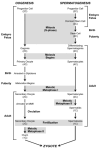Assessing human germ-cell mutagenesis in the Postgenome Era: a celebration of the legacy of William Lawson (Bill) Russell
- PMID: 17295306
- PMCID: PMC2071946
- DOI: 10.1002/em.20284
Assessing human germ-cell mutagenesis in the Postgenome Era: a celebration of the legacy of William Lawson (Bill) Russell
Abstract
Birth defects, de novo genetic diseases, and chromosomal abnormality syndromes occur in approximately 5% of all live births, and affected children suffer from a broad range of lifelong health consequences. Despite the social and medical impact of these defects, and the 8 decades of research in animal systems that have identified numerous germ-cell mutagens, no human germ-cell mutagen has been confirmed to date. There is now a growing consensus that the inability to detect human germ-cell mutagens is due to technological limitations in the detection of random mutations rather than biological differences between animal and human susceptibility. A multidisciplinary workshop responding to this challenge convened at The Jackson Laboratory in Bar Harbor, Maine. The purpose of the workshop was to assess the applicability of an emerging repertoire of genomic technologies to studies of human germ-cell mutagenesis. Workshop participants recommended large-scale human germ-cell mutation studies be conducted using samples from donors with high-dose exposures, such as cancer survivors. Within this high-risk cohort, parents and children could be evaluated for heritable changes in (a) DNA sequence and chromosomal structure, (b) repeat sequences and minisatellites, and (c) global gene expression profiles and pathways. Participants also advocated the establishment of a bio-bank of human tissue samples from donors with well-characterized exposure, including medical and reproductive histories. This mutational resource could support large-scale, multiple-endpoint studies. Additional studies could involve the examination of transgenerational effects associated with changes in imprinting and methylation patterns, nucleotide repeats, and mitochondrial DNA mutations. The further development of animal models and the integration of these with human studies are necessary to provide molecular insights into the mechanisms of germ-cell mutations and to identify prevention strategies. Furthermore, scientific specialty groups should be convened to review and prioritize the evidence for germ-cell mutagenicity from common environmental, occupational, medical, and lifestyle exposures. Workshop attendees agreed on the need for a full-scale assault to address key fundamental questions in human germ-cell environmental mutagenesis. These include, but are not limited to, the following: Do human germ-cell mutagens exist? What are the risks to future generations? Are some parents at higher risk than others for acquiring and transmitting germ-cell mutations? Obtaining answers to these, and other critical questions, will require strong support from relevant funding agencies, in addition to the engagement of scientists outside the fields of genomics and germ-cell mutagenesis.
Figures


Similar articles
-
Approaches for identifying germ cell mutagens: Report of the 2013 IWGT workshop on germ cell assays(☆).Mutat Res Genet Toxicol Environ Mutagen. 2015 May 1;783:36-54. doi: 10.1016/j.mrgentox.2015.01.008. Epub 2015 Jan 24. Mutat Res Genet Toxicol Environ Mutagen. 2015. PMID: 25953399 Review.
-
A Return to the Origin of the EMGS: Rejuvenating the Quest for Human Germ Cell Mutagens and Determining the Risk to Future Generations.Environ Mol Mutagen. 2020 Jan;61(1):42-54. doi: 10.1002/em.22327. Epub 2019 Oct 10. Environ Mol Mutagen. 2020. PMID: 31472026
-
Folic acid supplementation and malaria susceptibility and severity among people taking antifolate antimalarial drugs in endemic areas.Cochrane Database Syst Rev. 2022 Feb 1;2(2022):CD014217. doi: 10.1002/14651858.CD014217. Cochrane Database Syst Rev. 2022. PMID: 36321557 Free PMC article.
-
Somatic Mutagenesis in Mammals and Its Implications for Human Disease and Aging.Annu Rev Genet. 2018 Nov 23;52:397-419. doi: 10.1146/annurev-genet-120417-031501. Epub 2018 Sep 13. Annu Rev Genet. 2018. PMID: 30212236 Free PMC article. Review.
-
New approaches to assessing the effects of mutagenic agents on the integrity of the human genome.Mutat Res. 2007 Mar 1;616(1-2):83-9. doi: 10.1016/j.mrfmmm.2006.11.015. Epub 2006 Dec 15. Mutat Res. 2007. PMID: 17174354 Review.
Cited by
-
Chemotherapy-induced late transgenerational effects in mice.PLoS One. 2011 Mar 17;6(3):e17877. doi: 10.1371/journal.pone.0017877. PLoS One. 2011. PMID: 21437292 Free PMC article.
-
Stillbirth and neonatal death in relation to radiation exposure before conception: a retrospective cohort study.Lancet. 2010 Aug 21;376(9741):624-30. doi: 10.1016/S0140-6736(10)60752-0. Epub 2010 Jul 23. Lancet. 2010. PMID: 20655585 Free PMC article.
-
Comparison of germ line minisatellite mutation detection at the CEB1 locus by Southern blotting and PCR amplification.Mutagenesis. 2010 Jul;25(4):343-9. doi: 10.1093/mutage/geq011. Epub 2010 Mar 12. Mutagenesis. 2010. PMID: 20228094 Free PMC article.
-
Parental nutrient intake and risk of retinoblastoma resulting from new germline RB1 mutation.Cancer Causes Control. 2013 Feb;24(2):343-55. doi: 10.1007/s10552-012-0120-x. Epub 2012 Dec 8. Cancer Causes Control. 2013. PMID: 23224327 Free PMC article.
-
Radiotherapy for childhood cancer and risk for congenital malformations in offspring: a population-based cohort study.Clin Genet. 2009 Jan;75(1):50-6. doi: 10.1111/j.1399-0004.2008.01109.x. Epub 2008 Nov 17. Clin Genet. 2009. PMID: 19021636 Free PMC article.
References
Publication types
MeSH terms
Grants and funding
LinkOut - more resources
Full Text Sources
Medical

